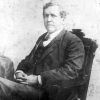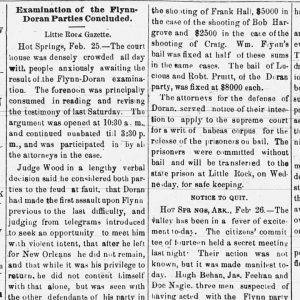calsfoundation@cals.org
Feuds
A feud (sometimes referred to as a vendetta or private war) is a long-running argument or period of animosity, especially between families or clans. Feuds usually begin over a perceived injustice or insult. The feud cycle is fueled by a long-running cycle of retaliatory violence that often escalates into a “blood feud,” in which the cycle of violence involves the relatives of someone who has been killed or dishonored seeking vengeance by killing the culprits or their relatives. In theory, the cycle of killing continues until one entire family has been killed.
Arkansas has had its share of feuds, particularly in the Ozark Mountains region of the state. Pioneers who came west from the southern Appalachian Mountains at the beginning of the nineteenth century settled the Ozark region. The Appalachians have a long, time-honored history of feuding, including the infamous Hatfield-McCoy feud. Many of Arkansas’s feuds were fought over land or water rights. However, the largest blood feud in Arkansas history was political in nature. The Tutt-Everett War (sometimes referred to as the King-Everett War) started over the political ambitions of two families—the Tutts and the Everetts.
In 1836, when the Arkansas General Assembly created Marion County out of portions of Searcy County, the Tutts and the Everetts vied for political control of the newly formed county, which was centered in its county seat of Yellville (Marion County). The Everetts (Sim, Jesse, and Bart) belonged to the Democratic Party and controlled most of the political and legal authority in Yellville. The Tutts, headed by R. B. Tutt and his sons (Ben, Hamp, and David Casey) belonged to the Whig Party and controlled most of the politics in Searcy County and the area of the county that was given to Marion County. The two families did not clash because of their differing political parties. Instead, what fueled their animosity toward each other was the political influence that one of the families was going to have to surrender to the other.
In June 1844, a public debate in Yellville turned into a drunken, violent brawl between the two families. A third family, the Kings (who were Whigs), joined the fight on the Tutts’ side. While many men were hurt during the melee, and one man (Sim Everett) was seriously hurt, no one was killed. The two factions subsequently armed themselves and occasional fights ensued. The feud became deadly on October 9, 1848, at a town meeting in Yellville, when several men, including Sim Everett, were shot to death. Two days later, the Everetts retaliated by ambushing “Old” Billy King and killing him and one of his sons, Lumus. The feud continued through September 1850, when Hamp Tutt became the last known victim of the Tutt-Everett War when he was ambushed and killed by unknown assailants.
Years later, the Hatfield-McCoy feud of West Virginia and Kentucky would become synonymous with American blood feuds; however, the Hatfield-McCoy dead only numbered twelve people, while the Tutt-Everett War had up to fourteen deaths.
The Smith-Nichols feud of Newton County started over a land dispute. Jeremiah Smith, who was head of the Smith clan, owned approximately forty acres of broad, fertile bottom land that bordered on land owned by Thomas Nichols. Bad feelings between the two families came to a head in August 1882, when Thomas Nichols announced a wedding celebration for Harmon Marion Nichols (a family member) and Sarah Hefley. Nichols invited all of his neighbors except Jeremiah Smith and his family.
The Smith family took offense at being left off the guest list, and the entire clan decided to attend the celebration anyway. The Nichols family hid guns throughout the house and barn and waited for the Smiths. As fiddles and banjoes played and wedding guests danced, the Smith family came galloping up on horseback, firing guns into the air. During the confusion and gunplay, Thomas Nichols was shot. He died the next day, on September 1, 1882. Six were arrested but only Alfred, Levi, and James Smith were brought to trial on July 6, 1883, for the murder of Nichols. The prosecution gave up after several of the attempts to reach a verdict ended in hung juries, and the defendants were set free.
Following the trial, the Nichols family vowed blood vengeance on Alfred Smith, whom they believed to be the Smiths’ leader. On July 7, 1884, John Wright and Thomas Nichols Jr. hid in ambush, and when Alfred Smith took his horse to the creek, either Wright or Nichols shot and killed Smith. The murder of Smith marked the end of the Smith-Nichols feud, but both families harbored ill feelings for decades. While no one was arrested for the murder of Alfred Smith, John Wright died on December 25, 1884, at the age of twenty-three, possibly becoming the final victim in the Smith-Nichols feud.
Other family feuds bloodied Arkansas soil in the late 1800s. Near Sheridan (Grant County), a blood feud between the Rhodes family and the Sneed family began when Richard Rhodes was hanged from an oak tree outside his home in November 1865 by a group of men seeking Rhodes’s hidden gold. The Rhodes family blamed Mann Sneed (a neighbor) and his family and cohorts. Open animosity existed between the families for years, reaching a boiling point in September 1884 when two Sneeds killed Jacob Rhodes, son of Richard Rhodes, over a land dispute. B. C. Sneed and Dink Sneed were convicted of manslaughter for this murder, and each served four years in prison.
The Terry-Wagoner feud (a.k.a. Ambrose-Terry feud) was a twelve-year-long blood feud that broke out along the Kings River on the Missouri-Arkansas border. This feud supposedly originated, in part, due to a group known as the Bald Knobbers, which was formed to combat the drinking, gambling, and fighting among bad elements along the border. Most of the violence in this feud was caused by members of the Ambrose family, and the last known killing associated with the feud was the murder of John Ambrose by F. S. Helt on July 4, 1895.
One of Arkansas’s most notorious feuds was also one of its last. The Hot Springs Shootout (March 16, 1899) was a direct consequence of the Flynn-Doran blood feud that lasted from 1884 until 1888. Frank Flynn controlled gambling in Hot Springs (Garland County) until former Confederate army major Alexander Doran began opening gambling houses there in 1884. The first blood was spilled when Flynn challenged Doran to a duel. Flynn was shot once in the chest but survived. Subsequently, murders and injuries were inflicted on both the Flynn and Doran factions. Finally, Doran was killed in 1888, ending the feud. The fight for control of gambling in Hot Springs continued, though, with the Hot Springs Police Department and the Garland County Sheriff’s Office on opposite sides. On March 16, 1899, police representatives from both departments met on the streets of Hot Springs and opened fire on one another. When the shooting was over, five people were dead and others were wounded.
Today, a melting of cultures, an appreciation of heritages, and better law enforcement and legal systems make blood feuds in Arkansas a thing of the past, although modern, urban gang violence (e.g., the Bloods versus the Crips) bears some of the hallmarks of vintage blood feuds. For some Arkansas families, however, vengeance, murder, and feuds still haunt their near past.
For additional information:
Blevins, Bill Dwayne. The Tutt & Everett War. Mountain Home, AR: Bill Blevins, 2002.
“Five Men Shot to Death: Pandemonium at Hot Springs.” Arkansas Gazette, March 17, 1899, p. 1.
Melton, Brad. “Bitter Quarrels: Feuding in the White River Basin.” White River Valley Historical Society 58 (Summer 2019): 18–20.
Larry LeMasters
LeMasters’ Antique News Service













Comments
No comments on this entry yet.